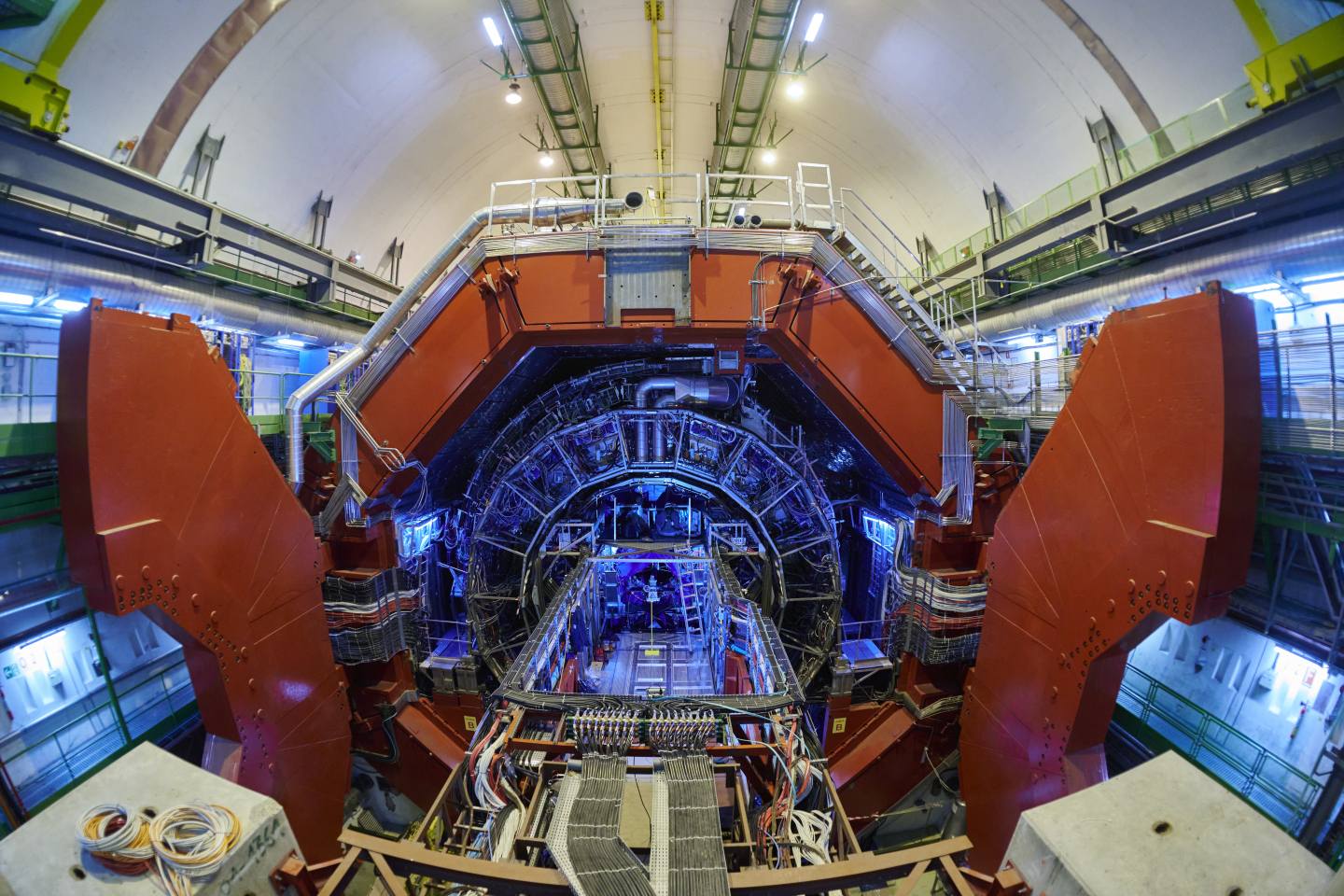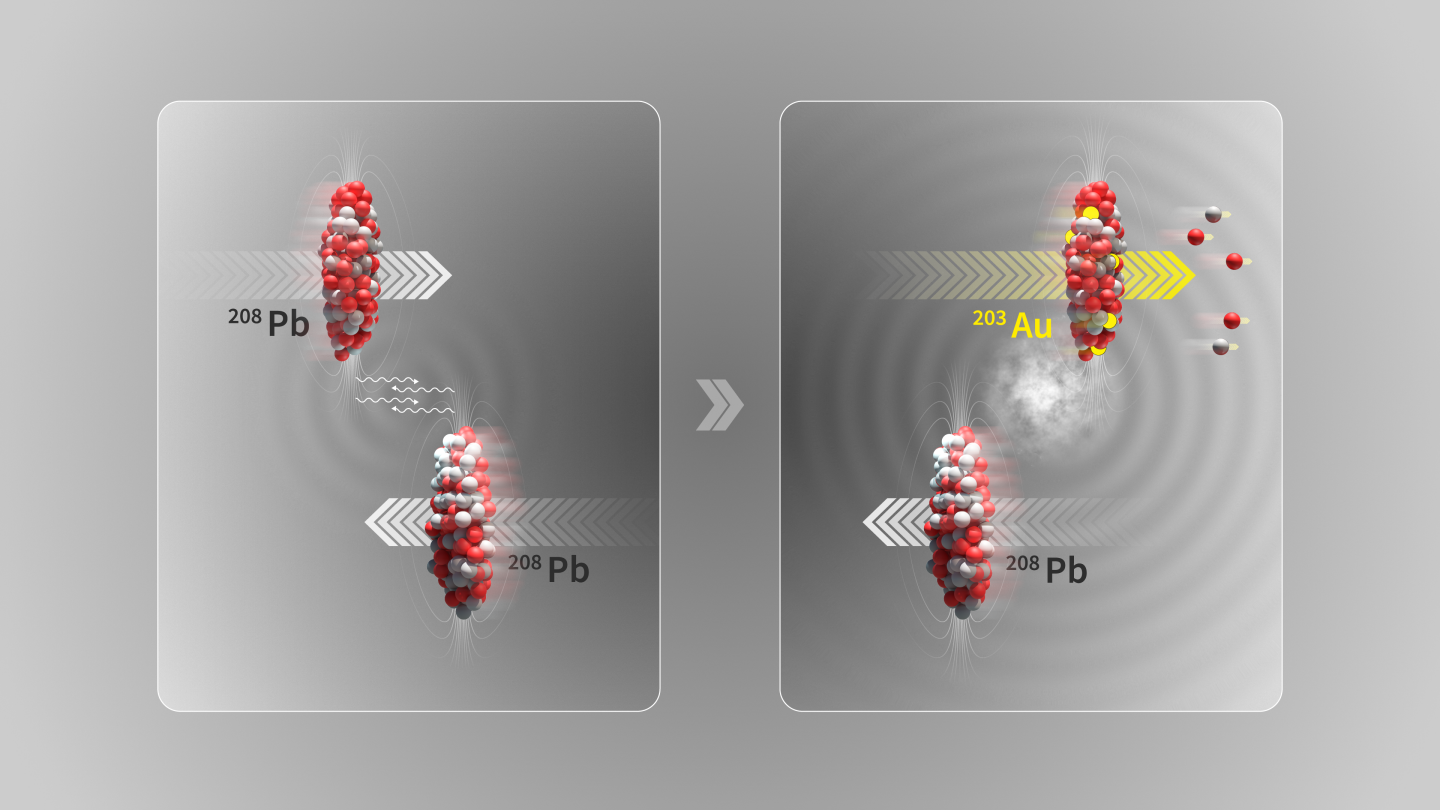ALICE detects the conversion of lead into gold at the LHC | CERN
Skip to main content

Toggle navigation
-
About
CERN
At CERN, we probe the fundamental structure of particles that make up everything around us. We do so using the world's largest and most complex scientific instruments.
Know more
Key achievements submenu
-
News
Featured news, updates, stories, opinions, announcements
At CERN
Press release
8 May, 2025
Physics
News
8 May, 2025
At CERN
Press release
17 April, 2025
Physics
News
10 April, 2025
Latest news
Press Room submenu
-
Science
Science

The research programme at CERN covers topics from kaons to cosmic rays, and from the Standard Model to supersymmetry
Know more
-
Resources
Featured resources
Courier
Physics
1 March, 2025
Image
Accelerators
20 June, 2018
Brochure
Knowledge sharing
10 May, 2022
See all resources
-
By Topic
-
By format
-
By audience
-
search
E.G. BIRTH OF WEB, LHC PAGE 1, BULLETIN... E.G. BIRTH OF WEB, LHC...
Search
Search
-
| en
News News Topic: Physics
Voir en
français
ALICE detects the conversion of lead into gold at the LHC
Near-miss collisions between high-energy lead nuclei at the LHC generate intense electromagnetic fields that can knock out protons and transform lead into fleeting quantities of gold nuclei
8 May, 2025

Picture of the ALICE detector (image: CERN)
In a paper published in Physical Review Journals, the ALICE collaboration reports measurements that quantify the transmutation of lead into gold in CERN’s Large Hadron Collider (LHC).
Transforming the base metal lead into the precious metal gold was a dream of medieval alchemists. This long-standing quest, known as chrysopoeia, may have been motivated by the observation that dull grey, relatively abundant lead is of a similar density to gold, which has long been coveted for its beautiful colour and rarity. It was only much later that it became clear that lead and gold are distinct chemical elements and that chemical methods are powerless to transmute one into the other.
With the dawn of nuclear physics in the 20th century, it was discovered that heavy elements could transform into others, either naturally, by radioactive decay, or in the laboratory, under a bombardment of neutrons or protons. Though gold has been artificially produced in this way before, the ALICE collaboration has now measured the transmutation of lead into gold by a new mechanism involving near-miss collisions between lead nuclei at the LHC.
Extremely high-energy collisions between lead nuclei at the LHC can create quark–gluon plasma, a hot and dense state of matter that is thought to have filled the universe around a millionth of a second after the Big Bang, giving rise to the matter we now know. However, in the far more frequent interactions where the nuclei just miss each other without “touching”, the intense electromagnetic fields surrounding them can induce photon–photon and photon–nucleus interactions that open further avenues of exploration.
The electromagnetic field emanating from a lead nucleus is particularly strong because the nucleus contains 82 protons, each carrying one elementary charge. Moreover, the very high speed at which lead nuclei travel in the LHC (corresponding to 99.999993% of the speed of light) causes the electromagnetic field lines to be squashed into a thin pancake, transverse to the direction of motion, producing a short-lived pulse of photons. Often, this triggers a process called electromagnetic dissociation, whereby a photon interacting with a nucleus can excite oscillations of its internal structure, resulting in the ejection of small numbers of neutrons and protons. To create gold (a nucleus containing 79 protons), three protons must be removed from a lead nucleus in the LHC beams.
“It is impressive to see that our detectors can handle head-on collisions producing thousands of particles, while also being sensitive to collisions where only a few particles are produced at a time, enabling the study of electromagnetic ‘nuclear transmutation’ processes,” says Marco Van Leeuwen, ALICE spokesperson.
The ALICE team used the detector’s zero degree calorimeters (ZDC) to count the number of photon–nucleus interactions that resulted in the emission of zero, one, two and three protons accompanied by at least one neutron, which are associated with the production of lead, thallium, mercury and gold, respectively. While less frequent than the creation of thallium or mercury, the results show that the LHC currently produces gold at a maximum rate of about 89 000 nuclei per second from lead–lead collisions at the ALICE collision point. Gold nuclei emerge from the collision with very high energy and hit the LHC beam pipe or collimators at various points downstream, where they immediately fragment into single protons, neutrons and other particles. The gold exists for just a tiny fraction of a second.
The ALICE analysis shows that, during Run 2 of the LHC (2015–2018), about 86 billion gold nuclei were created at the four major experiments. In terms of mass, this corresponds to just 29 picograms (2.9 ×10-11 g). Since the luminosity in the LHC is continually increasing thanks to regular upgrades to the machines, Run 3 has produced almost double the amount of gold that Run 2 did, but the total still amounts to trillions of times less than would be required to make a piece of jewellery. While the dream of medieval alchemists has technically come true, their hopes of riches have once again been dashed.
“Thanks to the unique capabilities of the ALICE ZDCs, the present analysis is the first to systematically detect and analyse the signature of gold production at the LHC experimentally,” says Uliana Dmitrieva of the ALICE collaboration.
“The results also test and improve theoretical models of electromagnetic dissociation which, beyond their intrinsic physics interest, are used to understand and predict beam losses that are a major limit on the performance of the LHC and future colliders,” adds John Jowett, also of the ALICE collaboration.
Additional image:
 Illustration of an ultra-peripheral collision where the two lead (208Pb) ion beams at the LHC pass by close to each other without colliding. In the electromagnetic dissociation process, a photon interacting with a nucleus can excite oscillations of its internal structure and result in the ejection of small numbers of neutrons (two) and protons (three), leaving the gold (203Au) nucleus behind (Image: CERN)
Illustration of an ultra-peripheral collision where the two lead (208Pb) ion beams at the LHC pass by close to each other without colliding. In the electromagnetic dissociation process, a photon interacting with a nucleus can excite oscillations of its internal structure and result in the ejection of small numbers of neutrons (two) and protons (three), leaving the gold (203Au) nucleus behind (Image: CERN)
ALICE
Related Articles
Knowledge sharing
Press release
7 April, 2025
Physics
News
9 December, 2024
Physics
News
25 September, 2024
View all news
Also On Physics
Physics
News
10 April, 2025
Physics
News
3 April, 2025
Physics
News
28 March, 2025
Physics
Press release
25 March, 2025
Physics
News
20 February, 2025
Physics
News
19 February, 2025
Physics
News
5 February, 2025
Physics
News
23 January, 2025
Physics
News
19 December, 2024
View all news
Follow Us






More Social Media Accounts
Find us
CERN & You
General Information
Copyright © 2025 CERN



 Illustration of an ultra-peripheral collision where the two lead (208Pb) ion beams at the LHC pass by close to each other without colliding. In the electromagnetic dissociation process, a photon interacting with a nucleus can excite oscillations of its internal structure and result in the ejection of small numbers of neutrons (two) and protons (three), leaving the gold (203Au) nucleus behind (Image: CERN)
Illustration of an ultra-peripheral collision where the two lead (208Pb) ion beams at the LHC pass by close to each other without colliding. In the electromagnetic dissociation process, a photon interacting with a nucleus can excite oscillations of its internal structure and result in the ejection of small numbers of neutrons (two) and protons (three), leaving the gold (203Au) nucleus behind (Image: CERN)




